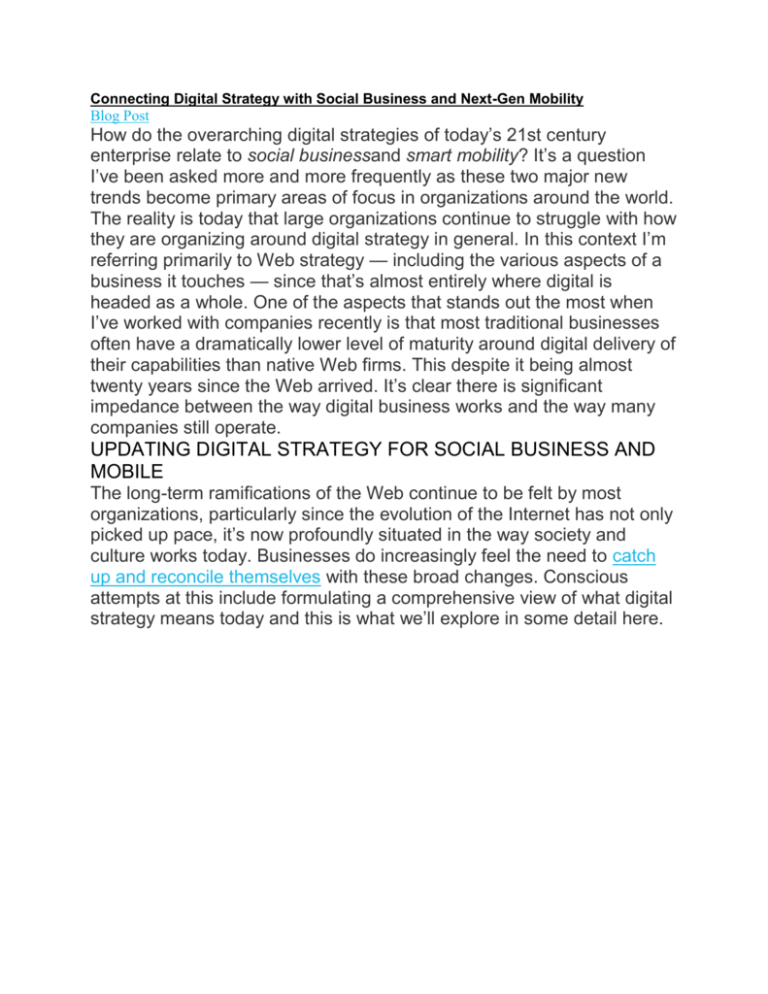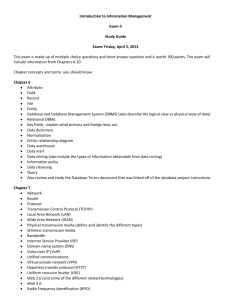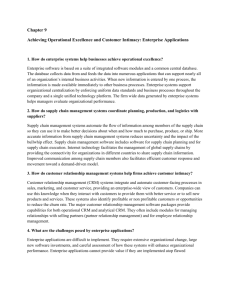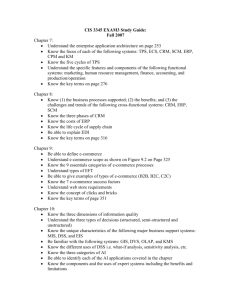updating digital strategy for social business and mobile
advertisement

Connecting Digital Strategy with Social Business and Next-Gen Mobility Blog Post How do the overarching digital strategies of today’s 21st century enterprise relate to social businessand smart mobility? It’s a question I’ve been asked more and more frequently as these two major new trends become primary areas of focus in organizations around the world. The reality is today that large organizations continue to struggle with how they are organizing around digital strategy in general. In this context I’m referring primarily to Web strategy — including the various aspects of a business it touches — since that’s almost entirely where digital is headed as a whole. One of the aspects that stands out the most when I’ve worked with companies recently is that most traditional businesses often have a dramatically lower level of maturity around digital delivery of their capabilities than native Web firms. This despite it being almost twenty years since the Web arrived. It’s clear there is significant impedance between the way digital business works and the way many companies still operate. UPDATING DIGITAL STRATEGY FOR SOCIAL BUSINESS AND MOBILE The long-term ramifications of the Web continue to be felt by most organizations, particularly since the evolution of the Internet has not only picked up pace, it’s now profoundly situated in the way society and culture works today. Businesses do increasingly feel the need to catch up and reconcile themselves with these broad changes. Conscious attempts at this include formulating a comprehensive view of what digital strategy means today and this is what we’ll explore in some detail here. Though recent global trends such as social media and next-generation mobile have both appeared over the last five years, an eternity in the online world, most businesses are still only engaging peripherally in these areas. They are the proverbial digital immigrants often significantly behind the curve compared to their Web native counterparts. While most companies have started using social media or providing mobile experiences, the efforts are often experimental and too-often poorly integrated with their older channels such as Web presence, traditional marketing, e-mail, etc. to be truly effective or transformative to their organization. The good news is that it’s abundantly clear that companies clearly perceive the need to change, even if they are experiencing continuing trouble in deciding on how best to proceed. For example, a new and more detailed breakdown of Jive’s recent social business survey shows that while three quarters of senior executives believe social media is of major importance to their business right now, only 27% think it’s a top strategic priority. However, as I recently explored in detail, there has already been a tectonic shift in the way the world communicates and engages. Traditional channels are declining rapidly in effectiveness, while new channels with entirely new sensibilities and modes of behavior are replacing them. We also should not forget that the shift to social business is far more than just a channel switch for the world population. Along with it comes a global behavior change in how the people engage with each other. This discussion holds true to a lesser extent of next-gen mobility as well. More importantly, while social business and mobility are sometimes perceived separately, a recent report on mobility by Forrester’s TJ Keitt, explains why they are so deeply connected and belong together, technology strategists “must now must have a mobile-first mindset when designing workplace policies.” CRAFTING THE BIG PICTURE As I alluded to above, a major question I’ve been getting from senior executives quite consistently recently is how these changes relate to the existing digital strategies they’ve been crafting and refining over the years. What they really want to know is if the strategic application of social mediaand next-gen mobility can be smoothly incorporated or otherwise slipstreamed into what they’re doing today. The short answer is that yes, there is clear overlap and connectedness in this space. But the less happy news is that that successful admission requires much deeper rethinking of the way the business operates, particularly the timeless issues of control, trust, and risk. This is part of the impedance I referred to earlier and is much harder for organizations to work through, which is why many have done so only partially. Consequently, much social business and next-gen mobility consists of “paving the cowpath” instead of getting down to the difficult yet rewarding work of transformation the organization to new modes of operation. Fortunately, part of the solution lies in clearly and explicitly connecting your digital strategy with social business and next-gen mobility instead of implementing it side-by-side or in a vacuum. Of course, it’s usually easier said than done. We should not forget that most digital strategies are reflections of the parts of the business that were involved in created them. Typically such initiatives are medium to long-term planning tools for marketing or customer relationship management (CRM) departments. Sometimes they are more B2B, Web presence, or e-commerce focused. But whatever their primary goal, the digital strategy picture of today’s business landscape must be complex, nuanced, and filled with a great many (and still growing) critical activities that must be addressed to remain relevant in the marketplace. Depicted above is an up-to-date representation of the major moving parts of a modern digital strategy, including how social business and next-gen mobility relate. It is not exhaustive but I believe it does successfully connect the main elements of Web strategy to the two major new components that most companies have now added to their operational priority lists in the last two years. Though every company’s digital strategy will vary, there are typically components of social business and mobile that aren’t part of a digital strategy proper yet are a pre-requisite for success. The level of appropriate cross-over is largely up to organizations to decide and prioritize for themselves. I should note that the view of digital strategy shown here holds fairly true for corporations, government, and non-government organizations and indeed, for most entities large and small. Note that this view does not include management, budgeting, policy, or governance functions, which are separate from this functional view of digital strategy. THE ELEMENTS OF DIGITAL STRATEGY Exploring the visual conception of digital strategy above, here is a brief tour through the various elements and how they are connected to and reinforce each other. These explanations are neither complete or sophisticated enough to use as their own basis. For that, you’ll need to delve into the subjects themselves and map your own requirements onto them. When possible, I’m provided supporting links and explanations to assist in this. The list below travels roughly clockwise around the digital strategy visual above starting with social media marketing: Social Media Marketing. One of the earliest areas of focus in social business, social media marketing remains a major strategic focus in most organizations and will be for some time. Covering an enormous amount of territory, social media marketing is typically the easiest and least risky to start with and is increasingly affecting all areas of digital strategy. Consequently, social media marketing is farthest along in capability in many organization skill levels, capability development in areas such as community management, tool selection, and so on. One of the biggest challenges in this area remains the impedance between push marketing and engagement marketing. In general, simply copying push marketing techniques into social media channels doesn’t work well. The best results come from strategically partnering with the marketplace to jointly co-create the the desired outcomes and network effects. Social media marketing is now near the end of its beginning, and a lot has been learned about how to unlock real ROI with it. Demand Generation. A relatively new aspect of digital marketing, demand generation consists of targeted digital awareness efforts to drive an understanding and interest in a product or service. Most frequently used in business to business, public sector, and longer term business-to-consumer (B2C) sales cycles, demand generation involves multiple areas of marketing. It has been described as the fusion of marketing and sales into a holistic effort using sophisticated support tools that combine data management and intelligence to reach strategic goals. Effective social business integration has also been appearing recently in demand generation platforms likeEloqua. Search Engine Optimization. Long a part of Web strategy, SEO is as important as ever as the proliferation of content accelerates. With pace of content creation increasing, the vast majority of it being user generated, SEO is the intentional treatment of Web markup to ensure that content, traditional and social media both, are readily discoverable. SEO is important both externally as well as internally to an organization and remains a key aspect of digital strategy, though internal implementation is typically neglected to the extent that productivity and efficiency suffers in many organizations making it difficult to locate information on intranets. SEO itself continues to evolve and expand as video, speech recognition (for audio), semantic, and social search engine optimization have entered the picture. Search Engine Marketing. Tightly coupled with SEO capabilities, SEM is the marketing aspect of SEO to promote Web sites and content to increase their visibility for sales and branding purposes. Social Networking Services (SNS) Apps. Applications embedded into social networks have become particularly significant as engagement mechanisms via the co-location of a convenient and potent user experience within the social networking experience. By tapping into users’ activity streams and social graphs, social networking applications have both the immediacy and full social context of their users to create a high-impact and shared social experience. SNS apps run the gamut of purposes including informational, productivity, gaming, and marketing. Most popular in the consumer world, where market leader Facebook has hundreds of thousands of available apps, social apps are now beginning to move seriously into the enterprise as well. Online Advertising. While all businesses must have an online advertising strategy, I find that it is underaddressed in all but the most sophisticated Web industry firms where arbitrage and adaptive ad strategy is commonplace. For example, Amazon allows competitive ads on their own product pages, allowing them to generate revenue on the momentary visitor engagement, even if the customer decide to purchase a product elsewhere. Advertising now goes well beyond text ads into sophisticated user experiences that leverage rich media, social media, cross-platform experiences, contests, co-creation, and carefully designed demand generation funnels. Consumer Social Media. The early world of consumer social media consisting of blogs, wikis, and simple social networks has exploded into a sophisticated world of global social networks, mobile applications, and aggregation involving the majority of the developed world population. Social business strategy connects to this complex landscape by exploring the many motivations and options in engaging with consumer social media to create better business outcomes. I find that many strategists are still not aware that most of the world now uses social media for communication and collaboration, over virtually all other forms of human interaction. Thus, if your organization is looking at engaging the marketplace, consumer social media is at the top of the list even while legacy channels still need to exist for continuity and consistency, while they still bring value. Social CRM. Customer relationship management has been moving into the social sphere for several years now, though the practice is still early in the maturity stages. CRM itself covers the gamut from sales, marketing, customer services, and technical support, and each one of these aspects can benefit from social media. Pre-sales Facebook engagement, online support communities, and crowdsourced technical support are typical uses of Social CRM, with world class examples being GetSatisfaction and Fixya, respectively, have shown that CRM costs can be significant reduced while simultaneously increasing customer satisfaction and loyalty. Customer Communities. A while back I noted that the best customer communities were often created by customers themselves, instead of by the companies whose products or services they care about. Intentionally creating a successful community is still more of an art form than science, yet some companies have been very successful at it, most notably SAP. Customer communities, which started as little more than online discussion forums, have gone on to become a key differentiator in the way that businesses engage with the marketplace. In this new era, the traditional static corporate Web site is usually a marginalized brochure, with the more meaningful and productive aspects of customer engagement taking place in the structured and unstructured activities of online communities. Community Management. A vital yet growing aspect of digital strategy, community management provides the needed oversight, moderation, and support that social media needs to be successful and sustainable long-term. Often informal, and increasingly recognized as a key function,community management has been gaining respect as a indispensable capability of modern digital experiences that can assure higher levels of success. Affiliate Portals and Communities. These days I hear from a lot of companies that no longer have the staff to reach out to and directly support thousands of business partners and affiliates. These can be everything from supporting broker networks and franchisees to managing suppliers and licensees. Private label communities and social networks have become a prime tool in servicing these constituencies with a fraction of the staff, yet frequently lead to higher levels of awareness, engagement, service, and transaction levels than before. Social Supply Chains and Open APIs. While supply chain management has been one of the last bastions of traditional business to be affected by social media, that is beginning to change. The most recent significant case study is Teva Pharmaceuticals, which reported a manufacturing cycle time reduction of 40% as well as reducing supplier lead time by up to 60% by applying social software to communication challenges. The other related — and just as big — story is open supply chains, typically via open APIs and supported through developer communities, which has lead to a major shake-up in the way business partnerships are digitally delivered. Innovation Management and Crowdsourcing. Peer-production of ideas and work has become an increasingly popular topic as the tools and techniques have matured. Idea management tools using social collaboration, such as Spigit, and crowdsourcing platforms like Crowdspring or Mechanical Turk have led to a small and steadily growing revolution in the way business gets done. I’ve explored the growth of this topic in detail before, but it’s clear it’s just ramping up as co-creation increasingly becomes the norm in the way innovation and work output is achieved today. Workforce Collaboration. Also known as Enterprise 2.0, internal social media has become a very popular topic in the enterprise these days. The way social media is entering organizations varies widely and will often form an initial beachhead in social content management, enterprise social networks, even (and more recently), unified communications. While interest in social intranets in particular is currently on the upswing, the business results are in from many different surveys and case studies: Information can be found faster, knowledge is retained better, and employees are more efficient and productive when there is widespread social collaboration. Web Presence. One of the earlier elements of Web strategy, Web presence now must take into account rich media, CRM, mobility, e-commerce, and more. Often Web presence is put into a silo next to, rather than integrated with, newer digital capabilities since the platforms and tools upon which it is based is either aging or technologically incapable of moving into the present. Web presence remains an important part of digital strategy, but its relevance is steadily being eroded by newer forms of engagement, particularly social media. Proactive firms will find ways to reconcile newer digital strategy elements with what’s becoming a legacy channel for a growing number of organizations. Microsites. The darling of targeted engagement a few years back, microsites remain a popular way to narrowcast online to a target audience or community to increase relevance, deepen reach, and foster engagement. Social microsites have become the next generation of microsite and it can be argued that Facebook pages themselves have become the ultimate microsite platform. E-commerce. The long and steady growth of e-commerce has continued unabated and is on pace to grow into a quarter trillion dollar business in the U.S. alone by 2014. The latest developments include the “Grouponing” phenomenon of connecting discount e-commerce to local business, mobile e-commerce and payment systems, as well as social SEO (now the leader in driving inbound leads) and gaming. Doing businesses online is a booming business, but new entrants will need to use existing distribution networks to catch up while deeply incorporating mobile and social into their efforts. Influencer Engagement. The premise here is that it’s more scalable and easier to reach influencers directly and take advantage of the audiences they’ve created for themselves, rather than reproduce their respective engagement level. While still an important part of any digital marketing strategy, influencer engagement remains largely a bespoke activity while the tools for doing it more scalably are still in their infancy. Analytics and Business Intelligence. Along with Big Data, analytics and business intelligence across the digital spectrum is one of the hot spaces in the industry right now for its promise to derive deep insights and harvest value from the endless streams of social activity taking place today. It’s one of the major reasons we developed and recently launched our Social Business Index and why other companies, such as Salesforce with their Radian6 acquisition, have been focusing their attention on it as well. The premise here is that companies that can make sense of combined behavior of their workers, customers, and partners and make meaningful use of their collective intelligence will have a real competitive advantage. Digital Branding. Branding remains an essential component of digital strategy, even while brands themselves are becoming ever more directly influenced by their customers. The rise in customer-driven marketing and advertising is only matched these days by related branding efforts, whichdespite cautionary notes to retain essential control, have already been conducted by some of the world’s largest and most influential companies including Ford, Kraft, and LG. E-mail Campaigns. While e-mail is finally in decline in terms of usage, it remains an integral part of digital strategy for the foreseeable future. With the rise of spam and social networks, e-mail is no longer the particularly appealing channel it once was yet it’s still an important touchpoint for CRM and to a lesser extent marketing. Location Services. Location-awareness consist of GPS, compass, RFID and other sensors in mobile devices to drive marketing, sales, CRM, and operations. Still in its early stages for most businesses, location-awareness can drive personalization, useful geographic context, analytics, and usage efficiencies in general for many kinds of applications. Digital strategies should maintain a proactive roadmap for where ambient location information can be incorporated over time to improve the digital user experience along with their supporting capabilities. Mobility Platform Support. Businesses are getting serious this year in adding support for iOS and Android platforms for service delivery of internal and external mobile applications. This requires application development capability and operations support as well as matching analytics, branding, advertising, and other related aspects of digital strategy. Mobile Content Enablement. Mobility support usually includes updating existing content and layout so that it works well with today’s newer mobile devices. This can be extensively automated and is also generally less challenging than developing entirely new mobile applications, though it is also often less effective. Content enablement for mobile can involve a wide range of activities including converting Flash to HTML 5 friendly formats, reformatting and testing Web forms and applications, and wholesale stylesheet/document repository transformation so that existing information assets are readily usable in popular mobile form factors. Consumer and Customer Mobile Apps. The barriers to delivering high quality user experience continue to drop as the cost of high quality mobile app development falls. There is no avoiding the fact that mobile apps are becoming one of today’s prime customer touchpoints. One of the single most effective ways to engage with someone under 30 is to have your app on the first or second screen of their smart mobile device. Mobile applications are on track to become one of the leading ways to engage in the digital marketplace. In my opinion, virtually all companies should be developing competency in this space and ensuring integration with the rest of their Web strategy. Mobile Messaging. SMS and MMS still have some life left in them and indeed remain one of the most popular communication services on the planet. However, they are threatened by new proprietary services such as Apple’s recently announced iMessage service and a growing chorus of independent providers such as Pinger’s popular Textfree app. Despite the technologies long history, businesses are just now beginning to build up real competency in mobile messaging for CRM and marketing (and to a lesser extent co-creation). The coming market fragmentation with major new non-carrier messaging services will likely just be a curve in the road. In general I anticipate that mobile messaging will be even more integrated into new digital touchpoints. Mobile Line of Business Apps. The internal business use of mobile apps is growing in leaps and bounds. Most CIOs I speak with these days are now under significant pressure to deliver existing services via iPads, tablets, and smartphones. While internal app stores are a few years away for most organizations, content and application enablement are now well under way in many companies. Digital strategies typically don’t explore internal apps nearly as much as external, but that may change given the amount of audience blur developing across the channel. Mobile Operations. A fair amount of operational competency and infrastructure development must be brought to bear the deploy the full experience of smart mobile in the enterprise. Bandwidth management for video chat is just one example of the headaches that mobile operations makes acute. Investment in all manner of smart mobile skills is another key area required to fully capitalize on what is one of the fasted growing segments of computing today. Operational capability is needed to deliver successfully on digital strategy in a timely fashion. Planners should be aware of capability levels and should proactive pursue and support funding to develop this area of their organization. Mobile App Stores. App stores are positioned to be the solution delivery conduit for both external and internal mobile applications for the foreseeable future. Digital strategies should plan for this on their roadmaps. While app stores are already the primary acquisition channel today on smart mobile devices, the enterprise itself (as well as the supporting technology) has a long journey to resolve issues around data security, provisioning, and governance. Mobile Security. Not part of digital strategy normally, yet impactful on it, mobile security is going to be a hot topic this year and next, particularly on platforms that are less controlled such as Android. Ensuring customers and workers have a safe and effective mobile experience will be a high priority — though sometimes a significant challenge — for those delivering through digital channels in the next few years. Content and Document Management. Social media has had a sustained and continuing impact on content and document management, to the extent that many of the latest iterations of these tools are major social platforms in their own right (such as Drupal). While this is true to a lesser extent in the enterprise, reconciling the current proliferation of social media, content management, and document management platforms, many which also connect to the public and have digital strategy implications, is one of the bigger challenges for IT departments right now. Intranet Strategy. Intranet strategy, a key aspect of social business, is usually not part of digital strategy proper but ends up being intertwined in it as the boundary blur continues to grow across worker to marketplace touchpoints. I’ve depicted the progression of intranets as one where social media is inevitably a key aspect, de facto or otherwise. Unfortunately, I expect that there will continue to be only a mild integration between digital strategy and intranet strategy given the diversity of their stakeholders. Unified Communication. Social business delivery will increasingly happen in unified communications channels, even if they often aren’t the monolithic software and infrastructure suites that were gaining some traction a few years ago. Unified communications is often moving inside social networks these days rather than the other way around (witness Skype integration with Facebook as just one example), though the jury is still out on IBM and Cisco’s offerings which are growing increasingly strong. Online Video and Podcasting. Rich media remains an important and significant part of digital strategy and social media (when it’s user generated.) However, the growth areas are in multipoint video chat, video archival and search, mobile video (both recorded and live broadcast), and of course, sharing capabilities. Integration of video into Web experience and applications is also increasingly popular and the case is increasingly being made that it’s a productivity driver as well. Digital strategies that treat video as a driver of network effect and accumulated value growth will have the largest long-term ROI. Those organizations that take the time to coherently plan their digital strategies, as long as they are agile and flexible in keeping them updated, revised, and connected to ground truth, will do far better than those that only adopt approaches ad hoc and hope for the best. For most however, digital strategy planning can be one of the most rewarding and beneficial tools in helping organizations rethink what they are doing in order to adapt to the seemingly onrushing future. Without appropriate care, however, they can also be an unrealistic albatross without deep connection to internal stakeholders and change champions that are effective in turning vision into reality. I urge you to look at the recent work on emergent strategy and business architecture as well as an updated view of IT consumerization to help you in your planning and create the best result. You may also find our new Social Business CIO Shortlist as well as the Social Business Landscape as useful cross-checking aids.







